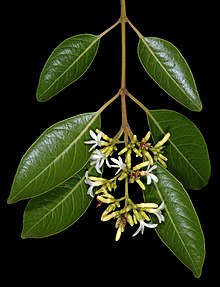This is an old revision of this page, as edited by Plantdrew (talk | contribs) at 01:32, 4 January 2020 (add image). The present address (URL) is a permanent link to this revision, which may differ significantly from the current revision.
Revision as of 01:32, 4 January 2020 by Plantdrew (talk | contribs) (add image)(diff) ← Previous revision | Latest revision (diff) | Newer revision → (diff)
| Diplorhynchus | |
|---|---|

| |
| Scientific classification | |
| Kingdom: | Plantae |
| Clade: | Tracheophytes |
| Clade: | Angiosperms |
| Clade: | Eudicots |
| Clade: | Asterids |
| Order: | Gentianales |
| Family: | Apocynaceae |
| Subfamily: | Rauvolfioideae |
| Tribe: | Melodineae |
| Genus: | Diplorhynchus Welw. ex Ficalho & Hiern |
| Species: | D. condylocarpon |
| Binomial name | |
| Diplorhynchus condylocarpon (Müll.Arg.) Pichon | |
| Synonyms | |
Diplorhynchus is a monotypic genus of plant in the family Apocynaceae found in tropical and southern Africa. As of August 2013 the World Checklist of Selected Plant Families recognises the single species Diplorhynchus condylocarpon.
Diplorhynchus condylocarpon grows as a shrub or small tree up to 20 metres (66 ft) tall, with a trunk diameter of up to 2 metres (6 ft 7 in). Its fragrant flowers feature a white to creamy corolla. Fruit is green or brown with paired follicles, each up to 6.5 centimetres (2.6 in) long. Vernacular names for the plant include "horn-pod tree" and "wild rubber". Habitat is dry woodland and hillsides from sea-level to 1,700 metres (5,600 ft) altitude. The plant's numerous local medicinal uses include as a treatment for indigestion, diarrhoea, fever, snakebite, infertility, venereal disease, diabetes, pneumonia and tuberculosis. D. condylocarpon is found in the Republic of Congo, the Democratic Republic of Congo, Tanzania, Angola, Malawi, Mozambique, Zambia, Zimbabwe, Namibia, Botswana and South Africa.
References
- ^ "Diplorhynchus", World Checklist of Selected Plant Families, Royal Botanic Gardens, Kew, retrieved 17 August 2013
- "Diplorhynchus condylocarpon". The Plant List. Retrieved 17 August 2013.
- Search for "Diplorhynchus", World Checklist of Selected Plant Families, Royal Botanic Gardens, Kew, retrieved 17 August 2013
- ^ Medicinal Plants. PROTA. 2008. pp. 229–230. ISBN 978-9-05782-204-9.
- ^ "Diplorhynchus condylocarpon". Flora of Zimbabwe. Retrieved 17 August 2013.
- Search for "Diplorhynchus condylocarpon", World Checklist of Selected Plant Families, Royal Botanic Gardens, Kew, retrieved 16 August 2013
External links
- Dressler, S.; Schmidt, M. & Zizka, G. (2014). "Diplorhynchus condylocarpon". African plants – a Photo Guide. Frankfurt/Main: Forschungsinstitut Senckenberg.
| Taxon identifiers | |
|---|---|
| Diplorhynchus | |
| Diplorhynchus condylocarpon |
|
This Apocynaceae article is a stub. You can help Misplaced Pages by expanding it. |